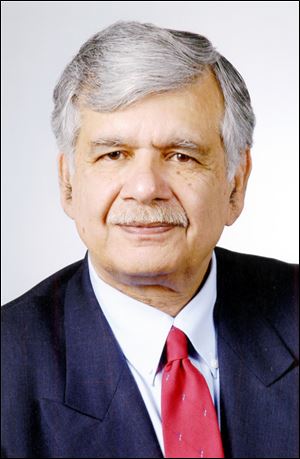
COMMENTARY
Sailing through history on Mediterranean cruise
Sea a conduit where disparate cultures interacted, clashed
7/21/2014
Hussain
A recent cruise took me to famous cities on the Mediterranean Sea. I have been to some of these cities before, but visiting them by sea was different. An added attraction was the company of my friends Naveed and Rehana Ahmed of Toledo.
The Regal Princess is the latest and biggest addition to the fleet of Princess Cruise ships. Sailing on this behemoth was like flying on a 747 jumbo jet for the first time. The ship had its maiden voyage a few months ago.
I was intrigued by the size of the ship and the number of passengers it carried. How would it feel to be a part of a floating city of 5,000 people, I wondered. And how does the ship handle emergencies and illnesses at sea?
The itinerary took us from Barcelona to Venice. There were stops at some of the usual tourist spots, such as Toulon, Rome, Istanbul, and Athens.
The constraints of visiting these cities for part of a day are obvious. These cities demand an in-depth visit not only to enjoy the sights, but also to understand the role they played in shaping human history.
Some people still carry the heavy burden of their ancient past with them. Our guide in Athens, a grandmotherly lady named Marietta, got emotional. Romans, Barbarians, Venetians, and Turks had at different times been villains, she told us.
The loss of Constantinople — now Istanbul — and the Aya Sophia church to Turks in 1453 is still a wound in the psyche of our guide and of millions of people like her. A few years ago, traveling on a train in Canada, I was taken aback by the expression of raw emotions by third-generation Greek-Canadians when the subject of Aya Sophia and Istanbul came up.
The advantages of cruises are obvious: plenty of sunshine, an abundance of good food, a variety of entertainment, and a bevy of well-trained and eager-to-please staff. The drawback is that there usually is a new port of call every day. A hurried march through some of the most amazing monuments humanity has created leaves you hungry for more.
I was interested in the medical facilities on board. Dr. Peter DuToit, the senior ship doctor, arranged a tour of the medical facilities. They include a self-contained, adequately equipped, six-bed modern hospital, including an intensive-care bed.
The medical staff sees about 30 patients a day and can take care of fractures, respiratory infections, and gastrointestinal ailments. Patients with serious illnesses are stabilized and taken off the ship at the next port of call.
Most of the staff was from the Philippines, Eastern Europe, or India. None of the officers was from a third-world country. This disparity was obvious.
So was the diversity among passengers. We had the opportunity to meet some fascinating people.
Two such people were a husband and wife, Latinos from Miami. I don’t recall their full names, but they told me their life stories. They were part of Operation Peter Pan, the 1962 Central Intelligence Agency undertaking in which 14,000 Cuban children were flown to Miami before Fidel Castro could tighten his grip on the country.
The couple met many years later in Miami, got married, and made a good life. They could have ended up in Soviet Union labor camps, where Castro was planning to send Cubans who opposed his revolutionary government.
The Mediterranean Sea has been part of the ebb and flow of fortunes made and lost along its shores. It provided a conduit where disparate cultures interacted and often clashed.
It has been the repository of those struggles and triumphs. The monuments and artwork along its shores point to the fascinating history of the region. It is a history worth learning.
Dr. S. Amjad Hussain is a retired Toledo surgeon whose column appears every other week in The Blade. Contact him at: aghaji@bex.net